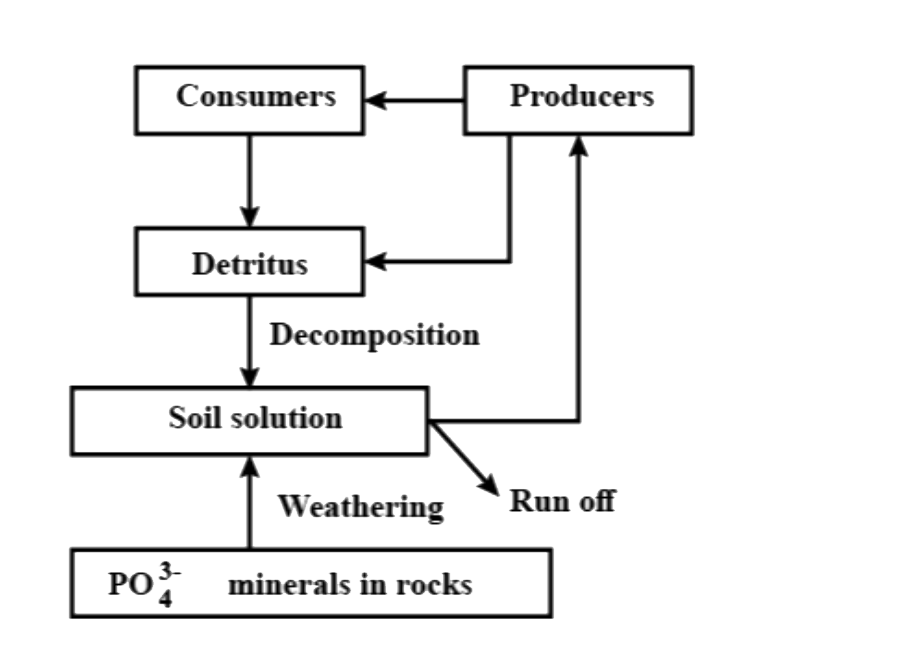Select the pairs of sediamentary biogeochemical cycles.
I. Hydrogen cycle and water cycle
II. Phosphorus cycle and sulphur cycle
III. Calcium cycle and magnesium cycle
IV. Carbon cycle and nitrogen cycle
I and II
II and III
III and IV
I and IV
The correct Answer is:B
To solve the question regarding the pairs of sedimentary biogeochemical cycles, we need to analyze each option given:
1. Understanding Biogeochemical Cycles: Biogeochemical cycles are pathways through which elements and compounds circulate in the biosphere. They can be categorized into different types: hydrological cycles, gaseous cycles, and sedimentary cycles.
2. Identifying Sedimentary Cycles:
- Sedimentary cycles involve non-gaseous elements and their major reservoir is the lithosphere.
- Examples of sedimentary cycles include the phosphorus cycle, sulfur cycle, calcium cycle, and magnesium cycle.
3. Analyzing Each Option:
- I. Hydrogen cycle and water cycle: The hydrogen cycle is a gaseous cycle, and the water cycle (hydrological cycle) also involves water in its gaseous form. Therefore, this pair is not sedimentary.
- II. Phosphorus cycle and sulfur cycle: Both of these cycles are sedimentary cycles, as they involve non-gaseous elements. This pair is sedimentary.
- III. Calcium cycle and magnesium cycle: Both of these cycles are also sedimentary cycles, as they involve non-gaseous elements. This pair is sedimentary.
- IV. Carbon cycle and nitrogen cycle: Both of these cycles are gaseous cycles, as they involve elements in their gaseous forms. Therefore, this pair is not sedimentary.
4. Conclusion: The correct pairs of sedimentary biogeochemical cycles are:
- II. Phosphorus cycle and sulfur cycle
- III. Calcium cycle and magnesium cycle
Thus, the answer to the question is that options II and III are the pairs of sedimentary biogeochemical cycles.
- Sedimentary cycles involve non-gaseous elements and their major reservoir is the lithosphere.
- Examples of sedimentary cycles include the phosphorus cycle, sulfur cycle, calcium cycle, and magnesium cycle.
- I. Hydrogen cycle and water cycle: The hydrogen cycle is a gaseous cycle, and the water cycle (hydrological cycle) also involves water in its gaseous form. Therefore, this pair is not sedimentary.
- II. Phosphorus cycle and sulfur cycle: Both of these cycles are sedimentary cycles, as they involve non-gaseous elements. This pair is sedimentary.
- III. Calcium cycle and magnesium cycle: Both of these cycles are also sedimentary cycles, as they involve non-gaseous elements. This pair is sedimentary.
- IV. Carbon cycle and nitrogen cycle: Both of these cycles are gaseous cycles, as they involve elements in their gaseous forms. Therefore, this pair is not sedimentary.
- II. Phosphorus cycle and sulfur cycle
- III. Calcium cycle and magnesium cycle
Topper's Solved these Questions
- ECOSYSTEMBOOK - NCERT FINGERTPS ENGLISHCHAPTER - ECOSYSTEMEXERCISE - Ecosystem
140 Videos
- BIOTECHNOLOGY AND ITS APPLICATIONBOOK - NCERT FINGERTPS ENGLISHCHAPTER - BIOTECHNOLOGY AND ITS APPLICATIONEXERCISE - Biotechnology And Its Application
137 Videos
- ENVIRONMENTAL ISSUESBOOK - NCERT FINGERTPS ENGLISHCHAPTER - ENVIRONMENTAL ISSUESEXERCISE - Environmental Issues
142 Videos
Similar Questions
Calvin cycle is
View SolutionBiogeochemical cycling means
View SolutionName two types of biogeochemical cycles.
View SolutionBiogeochemical cycles are also called
View SolutionKreb's cycle
View SolutionKrebs cycle is
View SolutionThe diagram/flow chart represents which of the sedimentary biogeochemical cycle ?

(a) Nitrogen cycle
(b) Phosphorus cycle
(c) Oxygen cycle
(d) Sulphur cycle
View SolutionWhich biogeochemical cycle is fully balanced?
View SolutionIn Krebs cycle,
View SolutionIn Kreb's cycle
View Solution
